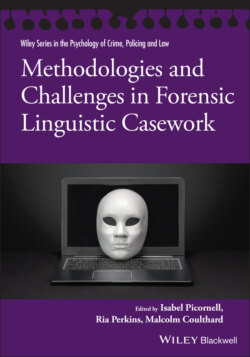Читать книгу Methodologies and Challenges in Forensic Linguistic Casework - Группа авторов - Страница 34
REFERENCES
Оглавление1 Argamon, S. (2018). Computational forensic authorship analysis: Promises and pitfalls. Language and Law/Linguagem E Direito, 5(2), 7–37.
2 Biber, D. (1995). Dimensions of register variation. Cambridge University Press.
3 Coulthard, M. (2004). Author identification, idiolect, and linguistic uniqueness. Applied Linguistics, 25(4), 431–447.
4 Dror, I. E., Peron, A. E., Hind, S. L., & Charlton, D. (2005). When emotions get the better of us: The effect of contextual top-down processing on matching fingerprints. Applied Cognitive Psychology, 19(6), 799–809.
5 Dror, I. E., Charlton, D., & Péron, A. E. (2006). Contextual information renders experts vulnerable to making erroneous identifications. Forensic Science International, 156, 74–78.
6 Dror, I. E., & Hampikian, G. (2011). Subjectivity and bias in forensic DNA mixture interpretation. Science & Justice, 51(4), 204–208.
7 Forensic Regulator. (2015). Cognitive bias effects relevant to forensic science examinations. Home Office.
8 Grant, T. (2012). TXT 4N6: Method, consistency, and distinctiveness in the analysis of SMS text messages. Journal of Law & Policy, 21, 467.
9 Grant, T. (2020). Text messaging forensics: Txt 4n6: Idiolect free authorship analysis? In M. Coulthard, A. May, & R. Sousa-Silva (eds.), The Routledge handbook of forensic linguistics (2nd ed.). Routledge.
10 Grant, T., & Baker, K. (2001). Identifying reliable, valid markers of authorship: A response to Chaski. Forensic Linguistics, 8, 66–79.
11 Grant, T., & MacLeod, N. (2020). Language and online identities: The undercover policing of internet sexual crime. Cambridge University Press.
12 Grieve, J. (2007). Quantitative authorship attribution: An evaluation of techniques. Literary and Linguistic Computing 22(3), 251–270.
13 Grieve, J., Clarke, I., Chiang, E., Gideon, H., Heini, A., Nini, A., & Waibel, E. (2019). Attributing the Bixby Letter using n-gram tracing. Digital Scholarship in the Humanities, 34(3), 493–512.
14 Grieve, J., & Woodfield, H. (2020). Investigative linguistics. In M. Coulthard, A. May, & R. Sousa Silva (eds.), The Routledge handbook of forensic linguistics (2nd ed.). Routledge.
15 Luyckx, K., & Daelemans, W. (2011). The effect of author set size and data size in authorship attribution. Literary and Linguistic Computing, 26(1), 35–55.
16 Wagner, S. E. (2012). Age grading in sociolinguistic theory. Language and Linguistics Compass, 6(6), 371–382.
17 Wright, D. (2017). Using word n-grams to identify authors and idiolects: A corpus approach to a forensic linguistic problem. International Journal of Corpus Linguistics, 22(2), 212–241.
